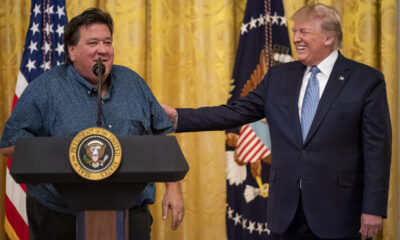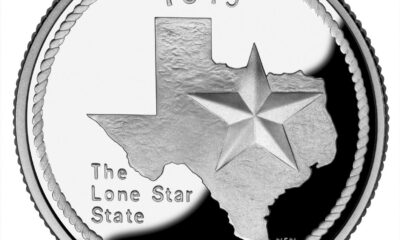Constitution
Texit – two bills to watch
Texit slowly finds direct support, and Texas continues to take steps that would make Texas independence practical. But Texas must do more.

Texit – the concept of Texas independence – has spawned at least one bill and can benefit from another. The Texas House Committee on State Affairs has both. Advocates for Texas independence seem to want to concentrate on one. But they dare not neglect the other.
The original Texit bill
The Texas Independence Referendum Act (HB 1359) reached the State Affairs Committee on March 5. Six days later, as many as five Members of the Texas State House signed onto it. Not much has happened since, however. The Texas Nationalist Movement has called on its Texas members to flood the office of Committee Chairman Chris Paddie with calls. But the TNM also cites a Bright Line Watch poll of voters in Southern states on the question of secession. Thirty-three percent of respondents surveyed agree that
… divisions within our country have grown so deep that we would be better off dividing into more like-minded regions that would govern themselves separately.
That includes 50 percent of Republicans, 45 percent of Independents, and 13 percent of Democrats. That thirteen percent of members of their own Party would sign onto secession ought to scare the Biden administration. Maybe they believe “if the other guys have their own country, we could build a progressive utopia.” But why would Democratic residents in the very States most likely to secede, take that sort of attitude?
Incidental findings
Incidentally, Bright Line Watch also has some stark revelations about election integrity and other issues. For instance:
Few Republicans profess confidence that election officials counted votes fairly and accurately in 2020. But fewer Independents profess such confidence than do Democrats. Nearly half of Independents surveyed profess little or no confidence in national election results.
Independents did not support the Second Impeachment of President Trump nearly as well as did Democrats. Only half of Independents wanted to disqualify Trump from running again. About the same number really believed Trump had committed any crimes.
Secession support did not limit itself to the South. Bright Line Watch surveyed all the States for secession sentiment. They found 41 percent support among Democrats in the Pacific States (California, Oregon, Washington, Alaska, and Hawaii), 34 percent support among Democrats in New England, and 34 percent support among Independents in the Heartland.
The “South” in view in the Bright Line Watch poll included the original Confederate States, plus Kentucky and Oklahoma.
One other finding gets little play in the Bright Line Watch report: the public has far less confidence in democratic institutions in America than have the “experts.” This is particularly true of confidence in the current state of election integrity. It applies even more to features like freedom of speech and allowing all parties. CNAV concludes that the “experts” are promoting a narrative they ought to know is false. And the public certainly knows that it is false.
Opposition to Texit within the Texas Legislature
Without question, the Texas Nationalist Movement cannot count on unanimous support in the Texas Legislature or even its Republican caucuses. Rep. Travis Clardy (R-Nacogdoches, Texas) seems to think that Texit would be a cowardly act. In fact he compared Texit advocates to the man who quit the Alamo before Santa Ana sacked it. Then he made several debatable statements about:
- The relationship between Texas and the United States, and
- The status of the United States as “the freest and oldest [democratic republic] in the world.”
In his presentation, Rep. Clardy gave one condition under which he would consider secession. And that would be if the United States were to collapse like the old Soviet Union.
Dan Miller, head of the TNM, challenged Rep. Clardy to a debate. Thus far, the Texas House member has declined even to acknowledge, much less accept, Mr. Miller’s challenge. No doubt Mr. Miller would be prepared to state that breaking away from a Union that is headed for collapse would not be cowardly at all. How could it be cowardly after Rep. Clardy has already cited the War Between the States as a precedent? Some might consider secession foolhardy, especially if those contemplating it did not prepare for war. But cowardly, it could not be.
The Texas Border Security Enhancement Fund Act
Key to Texit will, of course, be border defense. Bryan Slaton’s Texas Border Security Enhancement Fund Act (HB 2862) will help a great deal. For the first time since the adoption of the Constitution, a State will keep its own funds to finance:
- Border patrol operations, and
- Construction and maintenance of a border wall
along a border it shares with another nation-state.
This, along with Operation Lone Star, brings Texit closer in a practical sense.
The war-making power of a State under invasion
The U.S. Constitution reads in relevant part:
No State shall, without the consent of Congress … engage in war, unless actually invaded, or in such imminent danger as will not admit of delay.
Thus far the Biden administration has been too busy trying to take Americans’ guns away, or encourage people to mutilate themselves, to pay attention. Joe Biden has visited Texas only once, and that only to talk about the Texas Deep Freeze. He has yet to acknowledge that his abrupt Executive Order to all contractors on the border wall to down tools and leave drive-through breaches in place, has created a humanitarian crisis at a level one normally sees only after a Category Five tropical cyclone. Maybe that’s why he has not (yet) ordered the Texas National Guard and Rangers to stand down from the border. The minute he does, Governor Abbott declares that Texas is in “such imminent danger as will not admit of delay.” Or even that Texas has been “actually invaded.” And Biden would have none to blame but himself.
In addition, the Constitution says that no State may “keep troops or ships of war in time of peace.” But the Constitution does not forbid a State to fortify any part of its border. The Texas National Guard might qualify as “troops … in time of peace.” But the Congress has already consented to the keeping of such troops, with the Militia Act of 1903. The National Guard Act of 1933 redoubles that consent.
What this “Other Texit Bill” does
The Texas Border Security Enhancement Fund Act would create a fund to finance operations to:
- Interdict and apprehend illegal alien crossers and smugglers,
- Interdict and confiscate narcotics, other dangerous drugs, terrorist weapons, and other such contraband,
- Build and maintain a wall along the northern shore of the Rio Grande to secure the border, and
- Clear “non-indigenous plants,” whatever those might be.
The Legislature would appropriate money to go into the fund. The Comptroller would also invest the fund at interest and pay the interest back into the fund. In addition, the Governor would seek Federal reimbursement for any border-enhancement operation or project.
CNAV has read the Act and agrees with Rep. Slaton that it represents a good start. But it needs more work. Texas cannot count on reimbursement for border-enhancement operations or projects. Not from this Congress and certainly not from this administration. So the bill ought to provide for voluntary:
- Financial contributions directly to the fund, and
- Self-supporting auxiliaries coordinating with Texas National and State Guardsmen and Rangers.
The history of Chris Simcox’ original Minuteman Civil Defense Corps ought to guide Rep. Slaton and any joint or co-author(s). Mr. Simcox did organize self-supporting auxiliaries who spotted and reported illegal border crossers along a twenty-three-mile stretch of the U.S.-Mexican border. Border crossings along that stretch dropped to zero. If Mr. Simcox himself can’t do that today, others can. And Texas should work with them.
Moving from here to true Texit
The Texas Nationalist Movement insists that its own internal polling shows majority support in Texas for Texit. Obviously the Texit Bill, if it passes, will test this. The people can then vote: yes or no.
Suppose, then, that they vote Yes. Then a joint committee of the Texas Legislature forms to consider how to bring Texit about. This includes determining how to amend the Texas Constitution, and what laws to pass, to make Texit happen. (And also to protect Texans’ rights under the Texas Constitution as well as, or better than, the U.S. Constitution did.)
Naval assets
Preparing to defend Texas on land and, more vitally, at sea will present the trickiest challenge. The minute Texas acquires any functioning Naval assets, it runs afoul of the U.S. Constitution. Remember:
No State shall, without the consent of Congress, … keep troops or ships of war in time of peace.
Sadly, no such thing as a Naval National Guard exists or has ever existed. Therefore, Texas lacks the “consent of Congress” for keeping “ships of war.”
The old Battleship Texas is currently not battle-worthy. (See also here.) If it were, that would violate the Constitution. Certainly this old New York class dreadnought could not move very fast. But she is under repair, and will eventually go into drydock for further repairs. The aim is historical preservation – and that includes her big guns.
Besides the Texas, Texas has only one other potential Naval asset: USS Lexington CV-16. Until 1991, Naval jet pilot trainees would practice their first carrier landings on her deck. Typically a trainee, completing a successful landing on this short deck, could buy a T-shirt with this legend:
My first date was with an older lady.
Oddly enough, the Lexington has a reputation as a haunted ship! According to this account, Lexington figured in two popular pseudo-documentaries in which paranormal investigators looked for evidence of ghosts on board. She has also stood in for three other Navy aircraft carriers and even a Japanese carrier in film and television.
Air and ground assets
The Texas Military Department runs the Texas National Guard and Air National Guard, and the Texas State Guard. Those are within the Constitution, as Congress has effectively (see above) consented to Texas keeping troops in peacetime. Air assets fall within the meaning of troops in this context.
The Texas Air Guard has one each fighter, attack, and airlift wing. The fighter wing mainly trains pilots on F-16 fighters, but the attack and airlift wings are actually functioning operational units.
The Texas Army Guard consists mainly of a single division – but one with a history going back to World War One. Finally, the Texas State Guard serves as Texas’ homeland defense and emergency response corps.
Assets Texas could acquire to support Texit
CNAV reiterates its opinion that, should a Texit referendum return a Yes vote, irregular militia effectives would migrate to Texas. That migration could in fact start the instant HB 1359 passes. An Unauthorized Texas Militia could then form, and immediately augment Operation Lone Star.
Elon Musk has been building infrastructure in Texas to better support his auto manufacturing and spaceship development operations. Some of those, like his proposed tunnels in and near Travis County, could easily have military value. In addition, his SpaceX company has a number of merchant-marine assets, now including two floating oil rigs, that could become Naval support assets at least.
The Texas Legislature acted correctly in 2019 when they voted to support a program to save the Battleship Texas from the scrapyard. Now they have the chance to give Texas the beginnings of a fortified border. They should take it, and also give Texans a vote on whether to make Texit real.
List of earlier articles relating to Texas independence and readiness
Terry A. Hurlbut has been a student of politics, philosophy, and science for more than 35 years. He is a graduate of Yale College and has served as a physician-level laboratory administrator in a 250-bed community hospital. He also is a serious student of the Bible, is conversant in its two primary original languages, and has followed the creation-science movement closely since 1993.
-

 Civilization5 days ago
Civilization5 days agoIlhan Omar Did Not Flee From Oppression As A Refugee – She Was Fleeing Justice & Has Been Installed To Attack – This Video Speaks Loud & Clear
-

 Guest Columns4 days ago
Guest Columns4 days agoShe Saved Her Life. 7-Eleven Fired Her
-

 Civilization5 days ago
Civilization5 days agoThis Thanksgiving, Celebrate the New Beacon of the American Dream
-

 Civilization4 days ago
Civilization4 days agoDemocrats’ Viral Video Lights Match to the Republic
-

 Guest Columns3 days ago
Guest Columns3 days agoWaste of the Day: What’s Big, Grey And Costs $350K?
-

 Civilization3 days ago
Civilization3 days agoThe AI Challenge: Palantir, the Pope, and Paul Kingsnorth
-

 Civilization3 days ago
Civilization3 days agoNo Kings, No Queens, No Blind Loyalty
-

 Executive2 days ago
Executive2 days agoWaste of the Day: California’s $450 Million 911 Center Doesn’t Work













[…] week your editor described two important bills now pending in the Texas Legislature that relate to Texit. They include the […]
[…] the cold, and bad planningTexit – a real life updateTexit legislative and practical situationTexit – two bills to watchTexit – two opposing voicesTexas, power, and bad moneyTexit – if the vote were the other […]